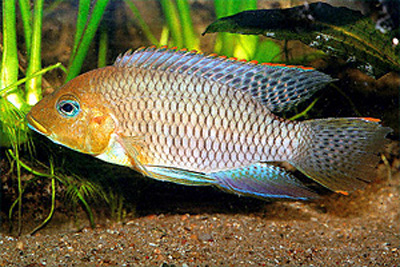| Cichlidae (Cichlids), subfamily: Incertae sedis |
| 12.1 cm SL (male/unsexed) |
|
pelagic; freshwater, |
| Africa: Kouilou-Niari and Loeme-Loukene basins(Republic of Congo), Nyanga and upper Ngounie basins and the Ogowe River (Gabon) (Ref. 81260). |
|
Dorsal spines (total): 13-16; Dorsal soft rays (total): 9-12; Anal spines: 3-3; Anal soft rays: 7-8; Vertebrae: 24-25. Diagnosis: relatively deep-bodied (Ref. 52307, 81260), particularly so in large specimens (depth 27.8-40.2% SL)(Ref. 8160). Head short (HL 31.9-37.2% SL); snout generally shorter than postorbital length; ascending process of premaxilla about one third longer than dentigerous arm; outer and inner row teeth in oral jaws unicuspid (Ref. 81260). Laterosensory system in the lachrymal bone with 5 openings (Ref. 45129, 52307, 81260). Infraorbital series complete (lachrymal bone and 4 other)(Ref. 45129, 81260). First pelvic fin ray longest in adults of both sexes (Ref. 45129), usually reaching anus or beyond (Ref. 81260). Pectoral fin somewhat shorter than pelvic; some dorsal and anal rays produced (branched dorsal rays 4-6, branched anal rays 4-5 longest), upper and lower caudal rays also produced in both sexes; caudal peduncle somewhat deeper than long (Ref. 81260). 2.3-3 scales between highest point of upper lateral line (about the 8-9th pored scale) and dorsal fin base; between the last 2-4 pored scale and the dorsal fin base 1 or 1 large and 1 very small scale (Ref. 45129). 12 circumpeduncular scales (Ref. 45129, 81260). Chest scales markedly smaller than flank scales (Ref. 81260). No sexual dimorphism in morphology or coloration (Ref. 45129).
Coloration: base body colour pale brown, cheeks and ventrum somewhat paler; usually 6-7 vertical bars on flanks; opercular spot well marked; reddish black maculae on caudal, soft dorsal and anal fins, often forming distinct bands proximally on the fins (Ref. 81260). Dorsal, anal and pelvic fins (Ref. 81260), and upper (Ref. 52307, 81260) and lower (Ref. 52307) edge of caudal fin, with narrow red margin (Ref. 52307, 81260), caudal fin also with thin white submargin (Ref. 52307). Lower edge of caudal with white margin; metallic (silvery) flush below red margin on soft dorsal fin (Ref. 81260). |
| Inhabits the middle and lower parts of the river basins; collection sites are in regions with primary or secondary forests. The water is clear with transparency of more than 100 cm, acidity approximately neutral (pH 7-7.5) with low conductivity (50 µS) and temperatures 21-22°C. The species lives syntopically with Chromidotilapia mamonekenei, which is more abundant than D. albimarginatus (Ref. 45129). Feeds on small particles (both animal- and plantbased), detritus and aufwuchs (Ref. 52307). Polygamous, ovophilic, female mouthbrooder (Ref. 81260). Possibly larvophilic (Ref. 52307). |
|
Least Concern (LC); Date assessed: 16 February 2009 Ref. (130435)
|
| harmless |
Source and more info: www.fishbase.org. For personal, classroom, and other internal use only. Not for publication.

